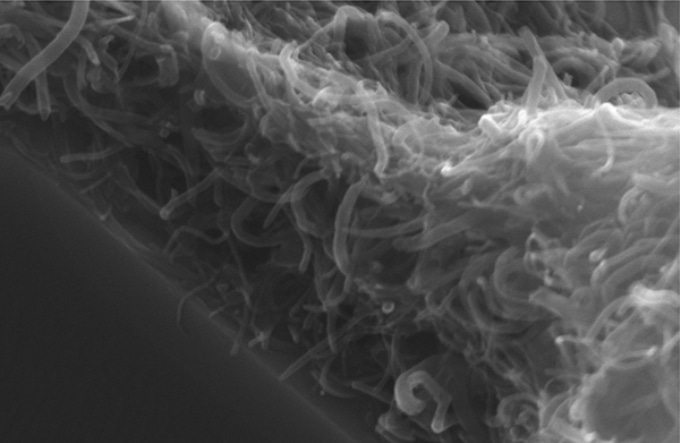Nov 23 2017
Distinctive and attractive characteristics of carbon nanotubes such as high electrical conductivity, exceptionally lighter weight and greater stability than steel will be suitable for a number of applications such as high-performance plastics, ultra-lightweight batteries, and medical implants.
Yet, until now, the transformation of the exceptional nano-scale properties into an operational industrial application has been very challenging in the field of science as well as in industry. Either it is hard to sufficiently integrate the carbon nanotubes with other materials, or even when they are integrated, they lose their advantageous characteristics later.
At present, researchers belonging to the Functional Nanomaterials working group from Kiel University (CAU) and the University of Trento have devised a substitutive technique for integrating the minute nanotubes with other materials such that their intrinsic characteristics are retained. In essence, the researchers “felt” the thread-form nanotubes into a stable 3D network with the potential to sustain extreme forces. The outcomes of the study have been published in Nature Communications, a renowned journal.
 In this new process, the tiny, thread-like carbon nanotubes (CNTs) arrange themselves—almost like felting—to form a stable, tear-resistant layer. CREDIT: Fabian Schütt.
In this new process, the tiny, thread-like carbon nanotubes (CNTs) arrange themselves—almost like felting—to form a stable, tear-resistant layer. CREDIT: Fabian Schütt.
A difficult candidate
The field of science and the industry have been extensively investigating the notably less than 100 nm broad carbon nanotubes, or CNTs, to tap the exceptional characteristics of rolled graphene. However, there is much more to it than just theory.
Although carbon nanotubes are flexible like fiber strands, they are also very sensitive to changes. With previous attempts to chemically connect them with other materials, their molecular structure also changed. This, however, made their properties deteriorate—mostly drastically.
Professor Rainer Adelung, Head of the Functional Nanomaterials working group, CAU
However, the technique adopted by researchers from Kiel and Trento is dependent on an uncomplicated wet chemical infiltration procedure in which the CNT are combined with water and made to drip onto an exceptionally porous ceramic material formed of zinc oxide, with the ability to soak in the liquid, similar to a sponge.
The thread-form CNTS that are dripped onto the porous material get attached to the ceramic scaffolding by themselves, and together spontaneously form a stable layer, like a felt. That is, the ceramic scaffolding gets coated with nanotubes. This results in astonishing effects not only for the scaffolding but also for the coating of nanotubes.
The 360° video illustrates how CNT networks are created:
Entstehung eines 3D-Netzwerks aus Kohlenstoffnanoröhren
Porous ceramics are produced at high temperatures, as shown here by the coalescence of the four-pronged particles, which join together like fine snowflakes that form a closed, but light blanket of snow. The interconnected particles are coated with a network of carbon tubes (represented as a transparent shell) and then etched out.
This multimedia simulation about the scientific work from the group pf Professor Rainer Adelung, "Functional Nanomaterials" at Kiel University, was developed as part of a cooperation project between the Kiel Science Outreach Campus and the Mediadome at the Zentrum für Kultur- und Wissenschaftskommunikation (Centre for Culture and Science Communication, ZKW) of Kiel University of Applied Sciences.
Copyright: Eduard Thomas, Kiel University of Applied Sciences.
Following the principle of bamboo buildings
For one thing, the ceramic scaffold’s stability gets increased to a point that it can nearly withstand weight that is 100,000 times of its own.
With the CNT coating, the ceramic material can hold around 7.5kg, and without it just 50g—as if we had fitted it with a close-fitting pullover made of carbon nanotubes, which provide mechanical support. The pressure on the material is absorbed by the tensile strength of the CNT felt. Compressive forces are transformed into tensile forces.
Fabian Schütt, First Author of the study
The concept behind can be compared with bamboo buildings, similar to the ones found in Asia where bamboo stems are connected very tightly using a simple rope such that highly stable scaffolding, or even whole structures, can be made by adopting the lightweight material.
We do the same at the nano-scale with the CNT threads, which wrap themselves around the ceramic material—only much, much smaller.
Helge Krüger, Co-author of the study
Using tiny carbon tubes to create high-performance plastics
Another significant benefit of the technique was exhibited by the materials scientists. In a subsequent step, the ceramic scaffolding was dissolved by adopting a chemical etching procedure. The remnant was a fine 3D network of nanotubes, where each tube consists of a layer of minute CNT. Adopting this process, the scientists could considerably increase the felt surface, thereby generating greater chances of reactions.
“We basically pack the surface of an entire beach volleyball field into a one centimetre cube,” noted Schütt.
Then, a polymer can be filled inside the large hollow spaces within the three-dimensional structure. In essence, CNT can be mechanically integrated with plastics, without altering their molecular structure, and hence their characteristics. “We can specifically arrange the CNTs and manufacture an electrically conductive composite material. To do so only requires a fraction of the usual quantity of CNTs, in order to achieve the same conductivity,” stated Schütt.
Simple procedure for numerous applications
These nanotubes can be used in battery and as a filling material for conductive plastics in filter technology, in implants for regenerative medicine, in sensors, and in electronic components at the nano-scale. In the future, the higher electrical conductivity of the tear-resistant material can be useful for applications such as functional clothing, flexible electronics or medical technology.
“Creating a plastic which, for example, stimulates bone or heart cells to grow is conceivable,” stated Adelung. Owing to its simple form, the researchers concur that the procedure can also be adopted for network structures formed of disparate nanomaterials, thereby further increasing the prospective applications of the nanotubes.